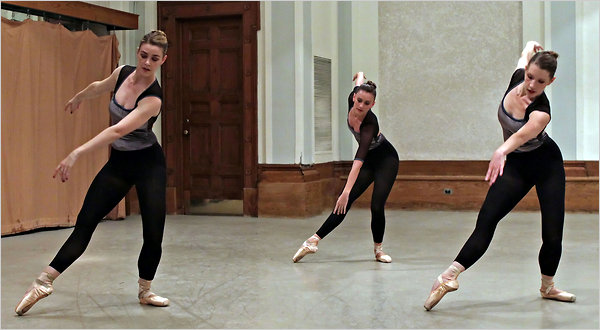The word “enterprising” always applies to New Chamber Ballet. On Saturday night at Studio 4 in New York City Center, in addition to its usual accomplishments of presenting new and recent choreography with live music, it offered a program set entirely to music written in the last 30 years. Let nobody underrate this. Of the dozens of ballets seen in New York in the last two months, how many have been to music more recent than Stravinsky or Britten?
But the New Chamber Ballet enterprise has its limitations, the most striking being its avoidance of stage lighting. The dancing occurs to exactly the same house lights that the audience enjoys in the intermissions. There are also no backdrops. Costumes are unobtrusive. Any sense of theatrical illusion depends entirely on the dancers and the choreography.
On Saturday, Emery LeCrone’s “Chamber Dances” (new in April 2010), to John Adams’s “Road Movies” for piano and violin, generated real excitement from its engagement with its score, its propulsive energy and its structural complexity, even though it was danced by three women alone. Ms. LeCrone, often responding to both pulse and melody in the music at the same time, creates spatially multidimensional works that make her dancers look galvanized both above and below the waist. She has a sense of gesture and a feeling for footwork. (In one solo, a woman moves quickly between her points, her heels and a repeated entrechat-quatre vertical jump in which the ankles crisscross in the air.)
When the music’s first and second movements end, Ms. LeCrone has built up enough dance momentum to continue the choreography through a few seconds of silence, arriving finally ready to start the next section. This device inevitably risks a sense of anticlimax (the audience has become used to the sense of dialogue between music and dance), but Ms. LeCrone judges it finely. Sometimes you want more than she gives you — more things going on at one time and considerably more dancers than three — but it’s a tribute to her skill that you can imagine her giving you more.
That work closed the program. Its fine dancers were Madeline Deavenport, Victoria North and Lauren Toole; its score was strongly played by Erik Carlson (violinist) and Melody Fader (pianist), regular players for New Chamber Ballet. The program’s other two dances were choreographed by the company’s artistic director, Miro Magloire. He, evidently, gives the company its sense of enterprise. The premiere on this program, “Love Song Solos,” was not only choreographed by him, but it was also to percussion music composed and even played by him. Yet it was in Mr. Magloire’s work that New Chamber Ballet risked being inconsequential in both expressive and musical terms.
Saturday’s program started with “The Game,” set by Mr. Magloire to Brian Ferneyhough’s “Unsichtbare Farben” (“Invisible Colors”) for solo violin. (At its premiere, in April, it was called “Table.”) The music is intense, with a wide range of dynamics and pitch, often suggesting more voices than one. But Mr. Magloire’s staging was principally sedate. Two seated women (Ms. Deavenport and Katie Gibson) faced each other, each with a hand of cards, across a table, at one end of which sat Mr. Carlson, playing the violin. At a few points one woman or the other rose to dance a solo. In one episode two solos coincided. Finally one dancer seemed to kill the other, or at least to bury her head into the table and scatter her cards.
Yet mostly the women just sat; occasionally they swayed from side to side with shifting shoulders. The card game seemed to bore both parties; the dance solos expressed no particular tensions that we might have imagined going on behind the card-playing. No differences between danced and undanced passages of music were apparent. Perhaps one solo briefly suggested suppressed grief, as its dancer very slowly buried her face in her hands; but it was hard to hear how this rose out of its music. This score is far more dramatic than this ballet.
“Love Song Solos” — danced by Ms. Gibson, Alexandra Blacker and Elizabeth Brown — is set to Mr. Magloire’s “Transcriptions of Schumann, Schubert, Brahms and Wagner,” but so arranged for two maracas that the original music is unrecognizable. (Mr. Magloire, introducing the work, explained that this idea arose because, though tempted by Brahms’s two sets of “Liebeslieder Waltzes,” he recognized that the precedents established by Balanchine and Mark Morris said, “Don’t go there.” One sequence of music by Mr. Magloire, danced by Ms. Brown, placed in my head Brahms’s song “Ein kleiner, hübsche Vogel” from the Opus 52 “Liebeslieder” set, but no other musical echo arose.)
Was this music and were these solos about love? Or anything? Each woman’s solo was long, punctuated by a few polite dance motifs. Ms. Brown, the third woman, had the biggest variety of mood, at one point running and dancing with a dark blue scarf held high à la Isadora Duncan. But the dance surface looked thin throughout “Love Song Solos,” and it was difficult to glimpse anything beneath that surface.
New Chamber Ballet performs next on Sept. 9 and 10 at City Center Studios, 130 West 56th Street, Manhattan, (212) 868-4444 or smarttix.com.
A version of this review appeared in print on June 27, 2011, on page C7 of the New York edition with the headline: Ballet and New Music Mix, Meet and Mingle.


Leave A Comment
You must be logged in to post a comment.